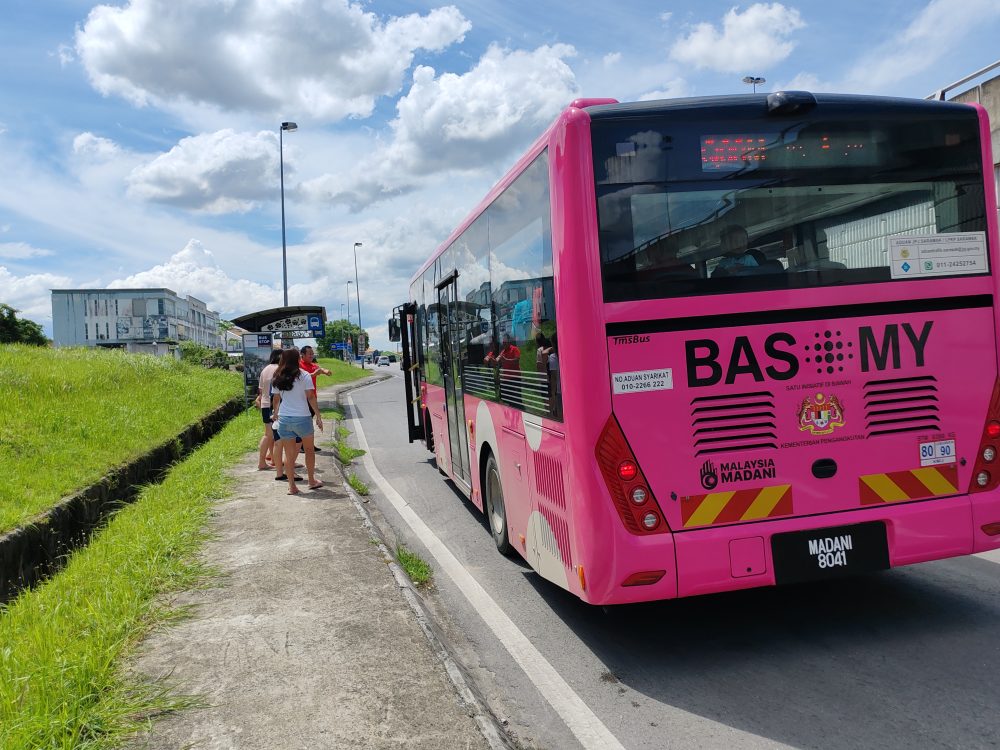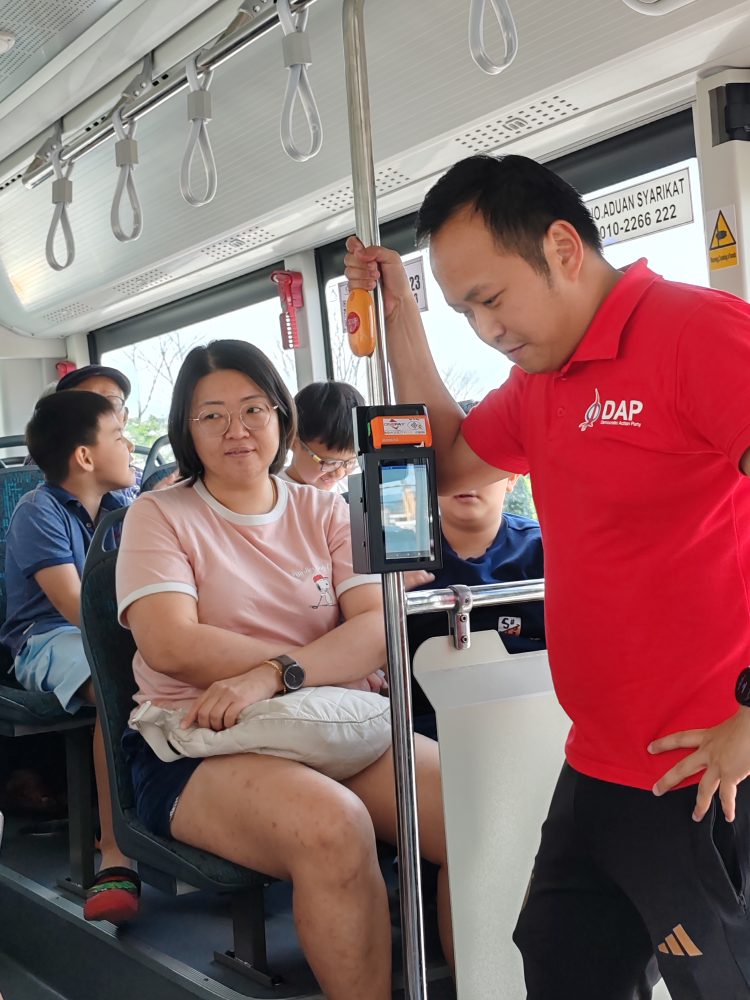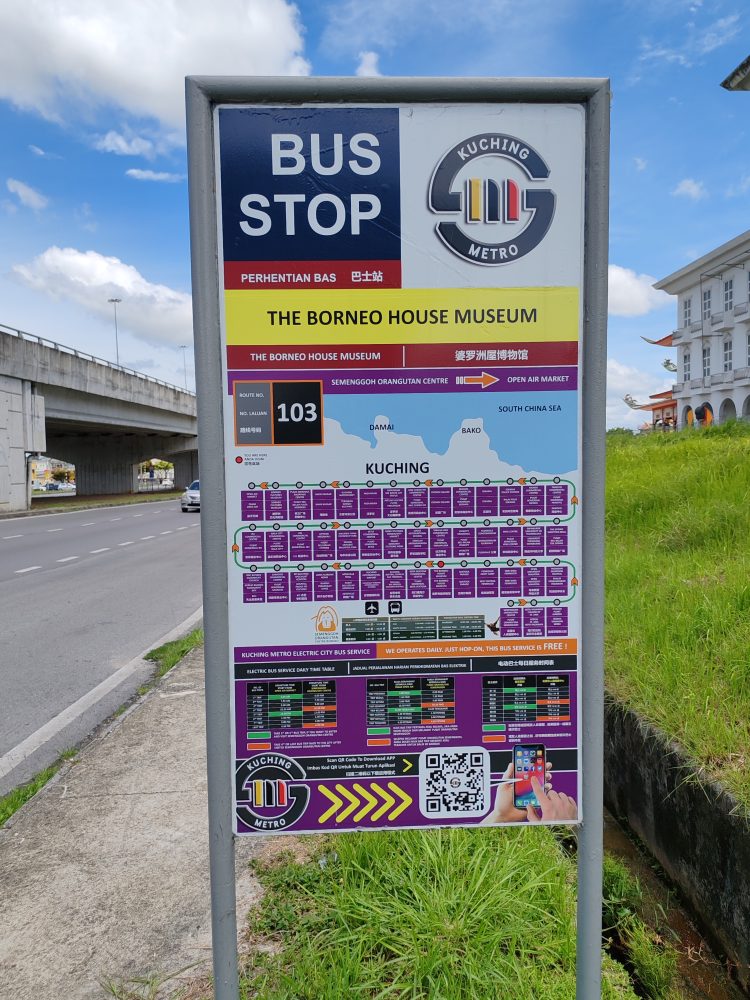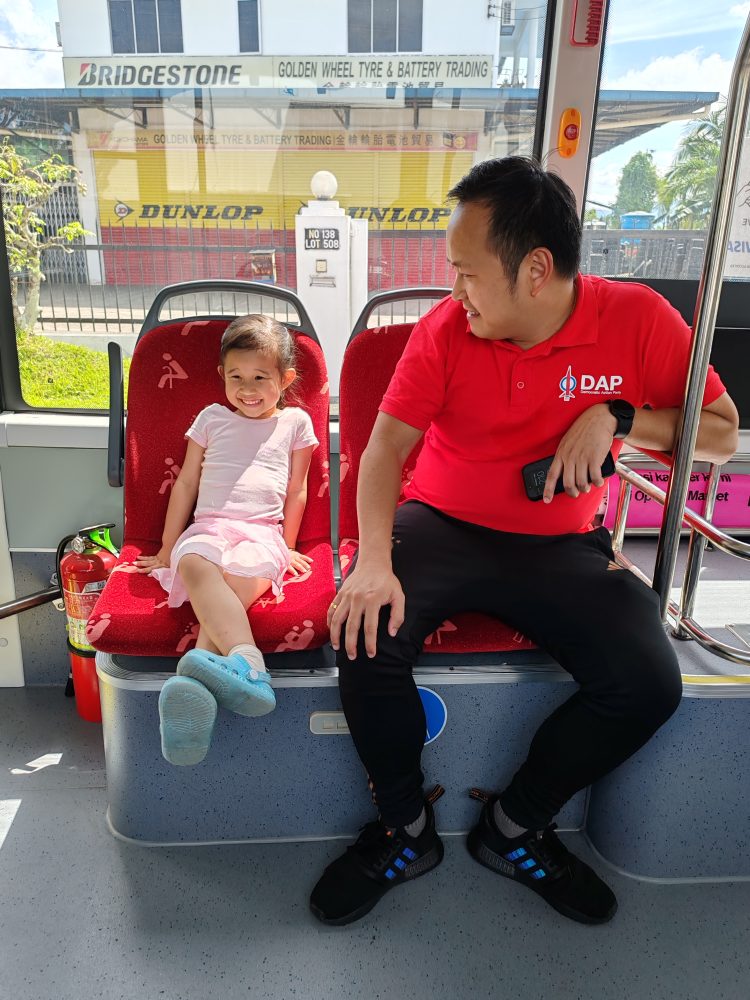
FOR many city children, getting on a bus can feel like an adventure especially for those who have never experienced it before.
On a recent hot morning, Michael Kong, Chairman of the Commercial Vehicle Licensing Board (LPKP) Sarawak, joined a group of city folks eager to experience both the joy and inconvenience of riding a public bus.
They boarded what is fondly referred to as ‘the pink bus’ at the Timberland bus stop, a strategic location that allows passengers to return safely via the nearby pedestrian flyover.
The group took the Q08B route, a new line that begins at Saujana in the city centre. It passes several key spots, including Timberland Medical Centre, Trinity Hub, Boulevard Shopping Centre, Farley Kuching, 7th Mile Market, Siniawan, SMK Paku, and Bau.

Stepping into the half-full, air-conditioned bus was a welcome relief from the heat, and the ride to Mile 7 was smooth and pleasant.
The group played ‘tourist’ and stopped for brunch at Mile 7. However, returning to the bus stop along Jalan Penrissen proved to be a challenge. The area lacks proper pedestrian walkways, and crossing the main road is risky due to the absence of safe crossings.
Kong pointed out that one of LPKP’s main challenges is the lack of basic infrastructure. He added that the local council, MBKS, does not permit them to build their own bus stops, even though many areas are in desperate need of them.
During the bus ride, Kong offered an insight on the issues facing the Bas MY and potential of it in years to come.
Question 1:
Many people see Bas MY as ‘the rakyat’s bus.’ In your view, what makes it more than just a means of transport but is often called a lifeline for rural and lower-income communities. Can you share Question 1 any real stories or feedback you’ve received that truly moved you?
One of the most common stories we hear is the infrequent and inconsistency in the city stage bus service in Kuching. That is what we try to help to change.
I once met Mr. Lim, a dialysis patient who rents a small room in Batu Kawah. He has to travel three times a week to Samarahan Heart Centre for dialysis. This journey requires him to take a bus from Batu Kawah to Open Air Market, then transfer to another bus to Samarahan Heart Centre.

At times, when buses were not operating and Mr. Lim was left stranded, unable to get to his treatment. Earlier this year, he faced another similar issue where there was a lack of bus transportation to Kota Samarahan. As such, he had no choice but to stay at the hospital for an entire week just to ensure he would not miss a single session.
This struck me as to how our public transportation really means a lot especially to those at the rural and lower income communities.
Question 2:
For many urban dwellers, public buses are seen as “old-school.” How do you change that perception, especially among the younger generation?
I think the perception is because they rarely see the buses on the road. Even when they do see one, it is most the time old looking and in a run down condition.

With the latest Bas.My Kuching, actually I have received a lot of feedback from people who told me that their children were asking ‘what is that pink bus?’. I believe that with the frequent sighting of these new and brightly coloured buses, the younger generation will start to look at public transportation differently.
Of course, the bus stop and our infrastructure also play a big part. They must be upgraded to be modernised and at least be given a renewed lease of life to also give confidence to the younger generation.
Question 3:
As Sarawak continues to grow, we ask how Bas MY plans to keep up and stay relevant for all?
The main thing is to try to get our buses to ply onto the road where people would use our buses. This one of our challenges – identifying which routes will have a higher demand for public transportation.
Currently, there is no data on the need for public transportation and all we can do is run by way of trial-and-error.

So we have to understand the need to be flexible and adapt quickly. Once we can identify areas that the demand is little or negligible, we will reroute the bus to serve other areas.
Hopefully with this, we can actually serve those that really need our service and that will keep us relevant.
Question 4:
Which areas are currently underserved, and are there active plans to extend Bas MY routes into more rural or interior regions?
Currently, we have identified areas such as Hui Sing, Stampin Resettlement Scheme, Kenyalang, Sekama and Ban Hock Road as areas that will need our service. So we will look into rerouting some of our existing routes to cover these areas.
Of course, we cannot forget other areas and we are looking into Bandar Baru Samarjang as well.
Question 5:
How does LPKP ensure that services remain accessible to vulnerable groups—like the elderly, disabled, and schoolchildren?
Firstly, we make the Bas.My Kuching free for those above 60, disabled and students. All they have to do is purchase a concession card for RM10 and that is it. With a low entry price point, it is the first pathway to making it accessible to them. Hopefully be doing this, we can encourage the other bus operators to do the same.
Secondly would be to make our buses accesible physically. We know how difficult it may be for those who wants to get on buses especially when they are those high platforms ones like express buses. So that is why we made it mandatory for all our buses to be low decked city buses (up to one step only). On top of this, there is also a ramp for those on wheelchairs to enter and exit our buses. Currently, Bas.My Kuching and Miri Smart Bus already comply with this standard and it’s a sign of what’s to come.
Question 6:
In a digital world, public transport needs to evolve. Here’s how Bas MY is—or isn’t—keeping up.
We have adopted technology in our buses such as Electronic Ticketing Machine on our Bas.My Kuching. This will also all debit and credit cards and well as e-wallet through Duit Now. But it doesn’t stop just there because we have plans to impose this on all city stage buses across Sarawak (be it Bas.My buses or not).
We have also decided that buses also must come equipped with GPS. We are putting the GPS of our Bas.My Kuching to good use by uploaded the data onto our mobile app called ‘Kuching Journey Planner’ where the public can use the app to plan their journey and also track the location of our buses.
We hope that this show the way forward to the bus operators. Fingers crossed, they too can adopt such technologies to better use.
Question 7:
What has been the toughest decision you’ve had to make as LPKP Chairman regarding Bas MY? How do you manage pressure from different stakeholders—be it local councils, transport operators, or politicians?
I think the toughest was to lower the age limit of our city stage buses from the previous 30 years to 20 years whole requiring all stage buses to be Low Decked City Bus in the future.
This drastic will mean that the current bus operators can no longer buy aged buses from Peninsular Malaysia for use by our local public. This also meant that the existing express bus operators cannot convert their buses to be a city stage bus once it reaches the age limit of an express bus (currently set at 18 years).
A lot of bus operators voiced out against this and said that it will kill their business. But as I told the board members, we have to bite the bullet and see through this for the benefit of the public.
For the operators, we have always been trying to support their industry through subsidies and we believe we will be able to find new ways to help them cope with the increased cost. But at the end of the day, the public deserves the best and not old second hand goods.
Question 8:
How do you respond to critics who say government-subsidised transport is “not sustainable” in the long term?
Public transportation has rarely been financially sustainable. Even in Singapore where the MRT ridership is high, we see SMRT losing money for years. This is because it is well understood that there is some other benefits that come along with a sustainable and efficient public transportation system such as lesser traffic congestion, lower carbon footprint, lower road maintenance, and etc.
Question 9:
Has LPKP ever considered using buses for multipurpose social initiatives—like mobile clinics, libraries, or food aid units in hard-to-reach areas?
Yes, we have to be adaptive to the society’s needs. But to do so, we also need to draft or fine tune our guidelines to cater to these new unconventional use of buses.
Question 10:
If budget were no issue, what would your ideal public transport system in Sarawak look like?
I would like a comprehensive stage bus system to serve each major city in Sarawak. To do this, there must be proper (and numerous) bus interchanges in each city to avoid a situation where everyone has to flock to one specific assembly point to change buses. We must upgrade our bus stops and bus stands to make them modern and comfortable.
On top of that, there should be sheltered walkways to link bus stops and allow pedestrians to walk around comfortably be it rain or shine.
Then we will need a railway system to link sarawak to Sabah (and if can Indonesia as well). This rail would carry or transport heavy industrial items like rocks while having some passenger carriage. This will help our public transportation sector while also taking away a lot of these heavy goods from public roads. In turn, this helps to reduce the burden on our road while keeping it safer with the reduction of heavy lorries.
Question 11:
What inspired your commitment to improving public transport? Is there a personal experience that shaped your outlook?
I grew up in Singapore during my high school days so I was lucky to be exposed to public transportation early on. Back then, my friends and I used buses for most of our trips. Even when the bus trip took us 45 minutes from boarding school to Orchard Road, we would willingly take the bus because it was cheap (only $0.55 for student fare) and we could all hang out & enjoy the ride comfortably.
When I went overseas to study my law degree, public transportation was also the norm. Even during my time travelling to places like Melbourne during my holidays, I would take the city tram to get around Melbourne City.
Seeing how everyone readily use public transportation overseas instead of driving made me appreciate public transportation even more. And I am determined to replicate its success here in Sarawak.
Question 12:
What are the most common complaints about Bas.My ? Late? Dirty?
It’s frequency. Currently due to our budget, we can only accommodate a frequency of one bus every 30 minutes during peak hours and one bus every 60 minutes during off peak hours. We admit that this is not ideal as frequency is a very important factor in public transportation.
By Connie Chieng